Family : Sphyrnidae

Text © Giuseppe Mazza

English translation by Mario Beltramini

Macolor macularis is an about 30 cm snapper present in the tropical waters of western Pacific and adjacent zones of Indian Ocean © Florent Charpin
The Midnight snapper or Midnight seaperch (Macolor macularis Fowler, 1931) belongs to the class of the Actinopterygii, the ray-finned fishes, to the order of the Perciformes, and to the family of the Lutjanidae, group that counts 17 genera and 113 species, present in the tropical and subtropical seas of all the world.
The name of the genus and of the species come both from the Latin “macula”, spot, as this fish has plenty of spots, both small, on each scale, both large on the back of the juveniles and of the subadults. The term snapper, used in English for the Lutjanidae, originates from”snap”, to break, to fracture, because these are fishes having solid teeth, mostly voracious predators upon small fishes and crustaceans, and for these characteristics in America they are considered as dentexes, hence also the Italian name of Dentice di mezzanotte.

It is found mostly alone between 2 and 90 m of depth. The big scales form thin blue hatchings and arabesques well visible on the head and the tending orange yellow cheeks © Florent Charpin
But, actually, even if at first sight these fishes resemble true dentexes, such as Dentex dentex, taxonomically they belong to the Lutjanidae and not, like the dentexes, to the family of the Sparidae.
The recurring current term of “midnight” is finally a further reference to the spots, bright as stars in the dark midnight sky.
Zoogeography
Macolor macularis is present western Pacific from the Ryukyu Islands up to Australia and then, indicatively, in Melanesia, Papua New Guinea, Solomon Islands, New Caledonia, Vanuatu up to Fiji and Tonga.

Two Macolor macularis images with wide-open mouth assisted by Labroides dimidiatus in a cleaning station. We note, besides the elegant drawings, the jaws conical teeth with dark lips, the showy notch on the preoperculum, the operculum pointed at the top, the gills and the yellow eye distinguishing this species from congener Macolor niger © Rafi Amar
In the Indian Ocean it is found at the Maldives, but they talk also of the Chagos and of south-western India, and it is possible that the range is wider because it is a species often mistaken with the analogous Macolor niger, present in the Indo-Pacific.
The juveniles are very similar and the adults could be distinguished at first sight due to the absence of the yellow eyes and to the fact that they move in dense schools.
But, conversely, these render the detections more difficult because they often host in their ranks some wandering Macolor macularis that in this way escapes control.
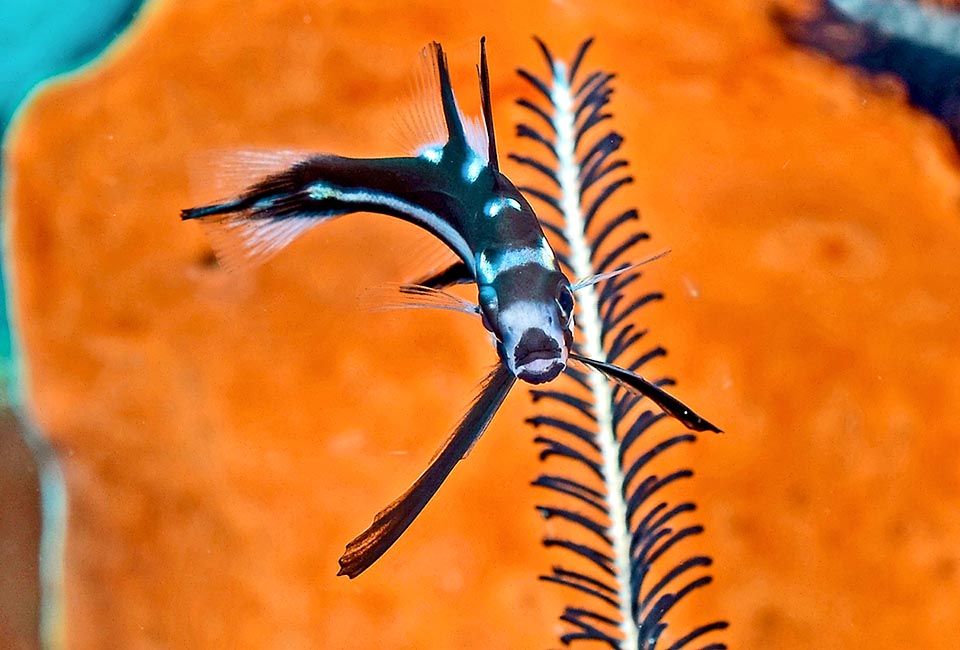
First age juvenile characterized by the huge pelvic fins. They grow up solitary, camouflaged among the arms of the feathery marine starfishes © Benoit Lallement
Ecology-Habitat
The Midnight snapper usually goes around alone or in small schools between 2 and 90 m of depth. The adults stand on the steep slopes of the reefs whilst the juveniles usually keep alone, camouflaged in the arms of the feathery starfishes and among the ramifications of the madrepores and of the black corals.
Morphophysiology
Macolor macularis may reach the length of 60 cm, but usually hardly exceeds half.
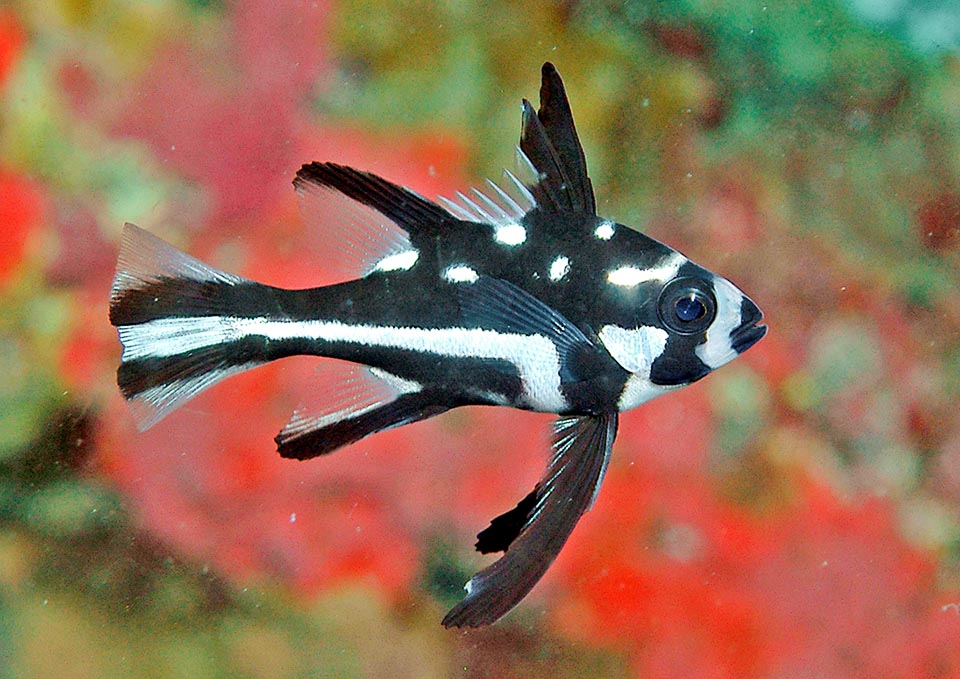
The juvenile livery is white and black. In this specimen, larger, we note an ample white stripe along the sides and some white spots on the back © Benoit Lallement
The body is relatively tall and compressed on the sides. The profile of the head, rectilinear in the juveniles, is istead convex in the adults.
The mouth is wide with dark lips and conical teeth on scaleless jaws. The preoperculum displays a showy notch at the height of the pectoral fin, whilst the operculum ends with a small point.
The dorsal fin with 10 spiny rays and 13-14 soft, and the anal with 3 spiny rays and 10 unarmed, are both pointed. The black pectorals, long and sharp, count 16-18 rays; the pelvics, short and rounded in the adults, are instead huge and pointed in the juveniles. The caudal, emarginated, is slightly toothed.
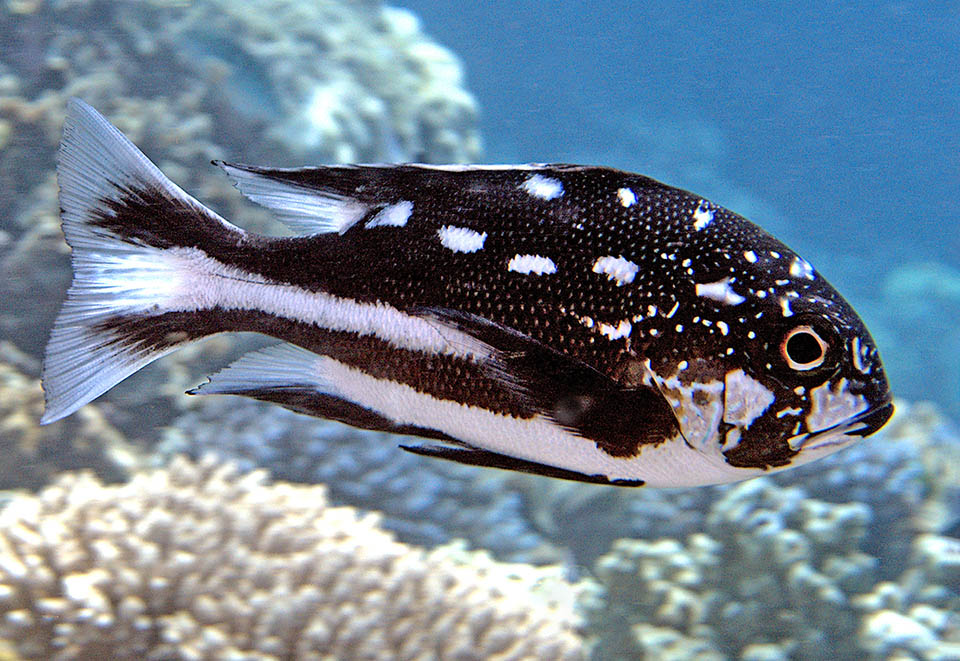
While growing the pelvic fins reduce and the profile of the head is not rectilinear any more as it was in the previous stage but becomes convex. The body has risen noticeably creating a second white ventral stripe and at least six big white spots towards back, whilst the head is mottled with thin stippled dots © Florent Charpin
The big scales, parallel to the lateral line, have mostly a large bluish grey spot that forms thin hatchings and arabesques well visible in blue on the cheeks tending to orange yellow as well as the lower part of the body.
The livery of the juveniles, changeable in the different stages of the growth, is decidedly different.
After childhood they are black with a wide white band on the sides, a second one on the belly, and at least six big white spots on the upper part of the body, whilst the head is mottled with subtle stippled dots. Finally, the black tends to brown, like the white bands that darken whilst the scales while growing display the typical clear lines.
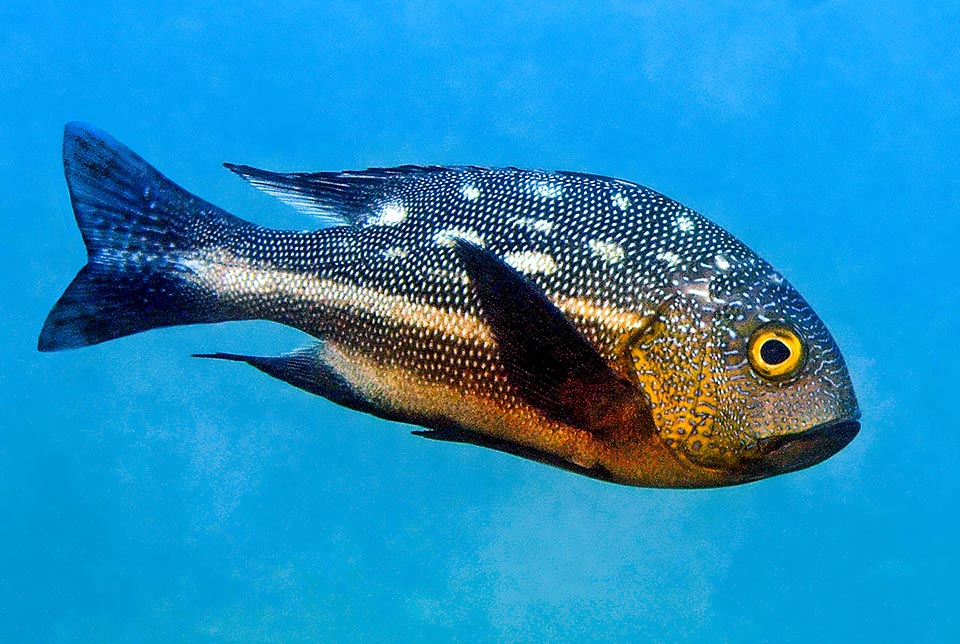
Here the longitudinal stripes have not yet disappeared but we get close also in colours to the adults livery with pale spots towards the back © Benoit Lallement
Ethology-Reproductive Biology
Macolor macularis nourishes, especially by night, of large zooplankton, small fishes and crustaceans.
It however respects the cleaning fishes, like the Labroides dimidiatus, who assist it in the so-called “cleaning stations”, where also big fishes do come, peaceful, open-mouthed, to have the gils and the skin parasites removed.
Little is known about the reproduction of Macolor macularis, but like other Lutjanidae the fecundated eggs are abandoned to the currents.
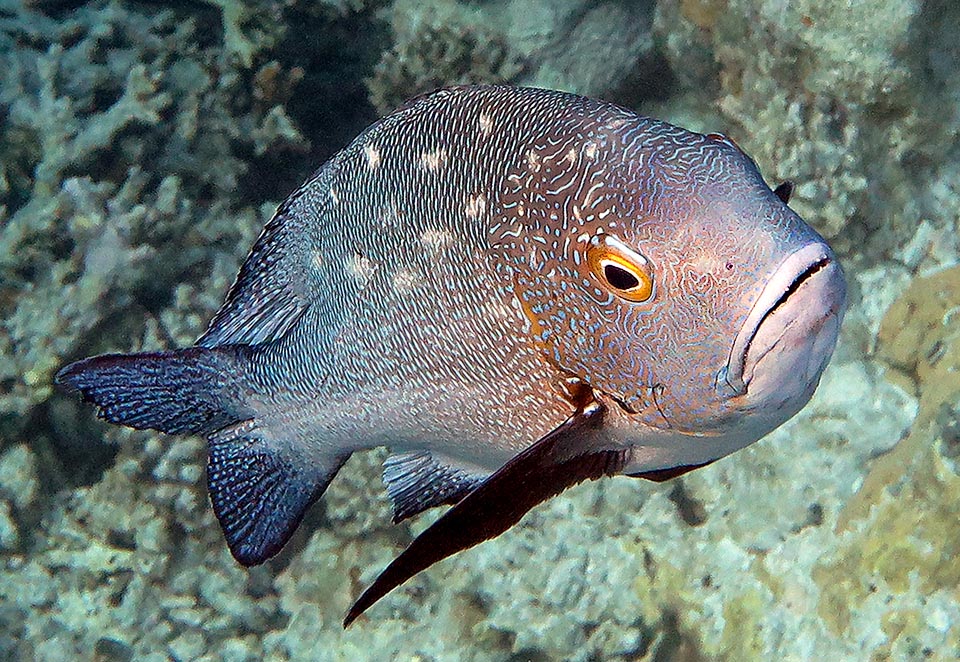
Subadult. The stripes have practically gone, are getting form the drawings of the head and then the lips will tend to black © Gianemilio Rusconi
The resilience of the species is mediocre, as the minimum time for doubling the populations is of 1,4-4,4 years, and the fishing vulnerability, moderate, marks 44 on a scale of 100.
The Midnight snapper is in fact present due to its flesh on the local markets, caught with gillnets, traps and lines to which we have to add the spearguns of the sport fishermen.
In any case Macolor macularis appears from 2015 as “LC, Least Concern” in the IUCN Red List of the endangered species.
→ For general information about FISH please click here.
→ For general information about BONY FISH please click here
→ For general information about CARTILAGINOUS FISH please click here.
→ To appreciate the BIODIVERSITY of BONY FISH please click here.
→ To appreciate the BIODIVERSITY of CARTILAGINOUS FISH please click here.
